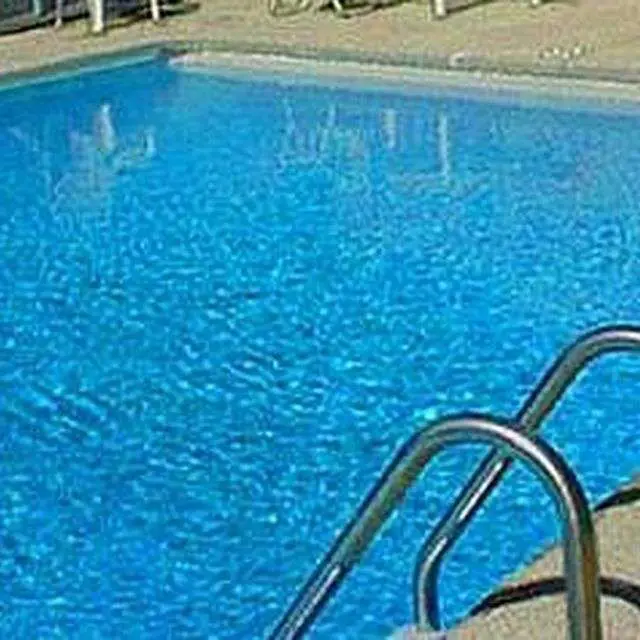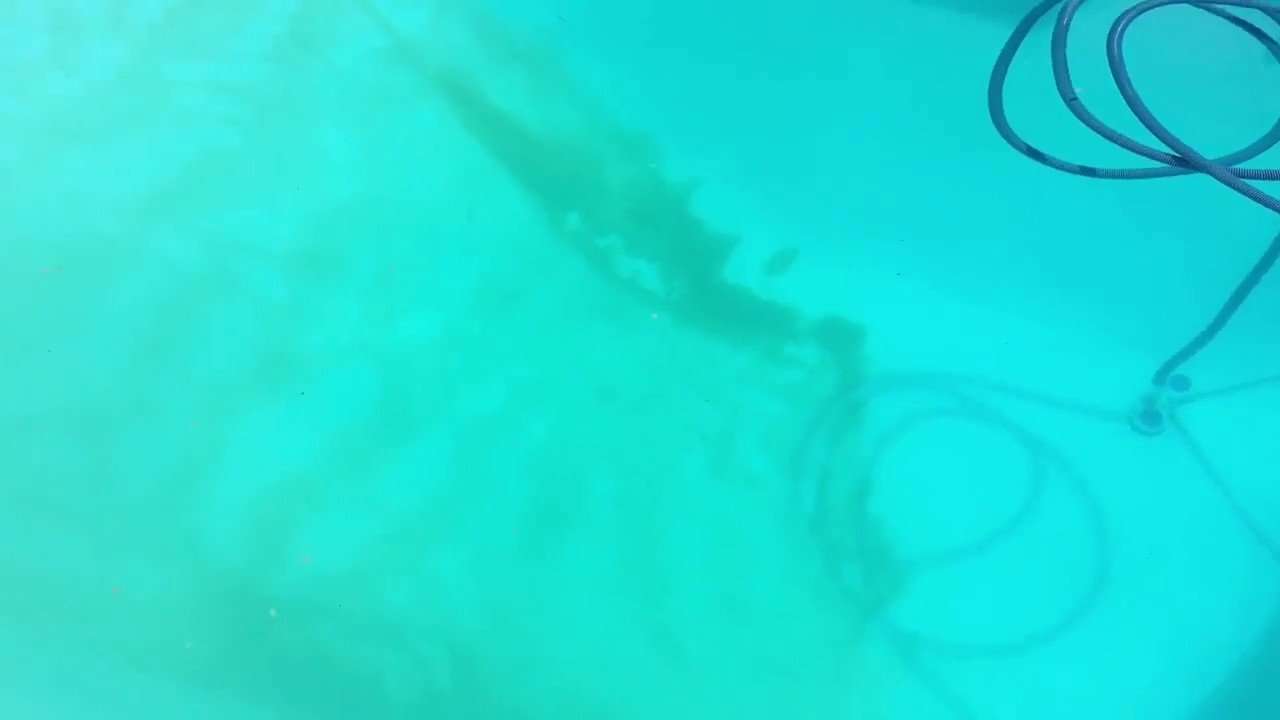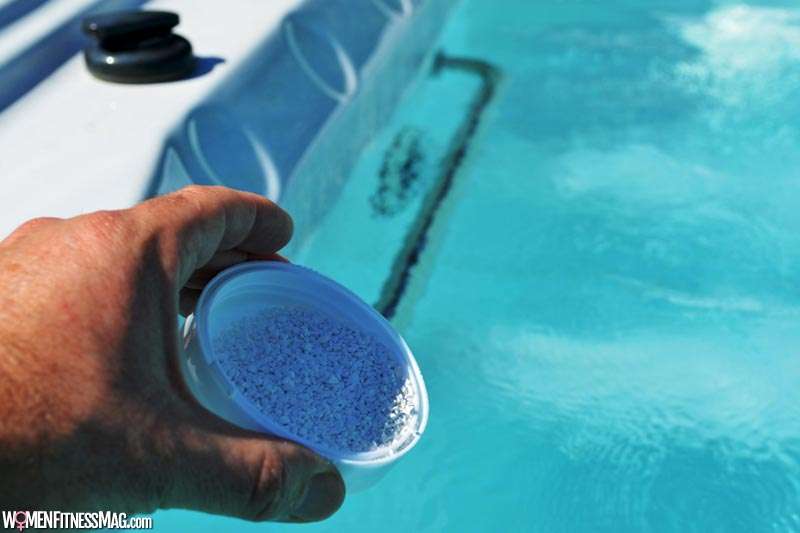During Extended Periods Of Hot Weather
When the weather is hot, the water levels will rise above the optimal temperature range of 78ºF82ºF, making it easier for bacteria and algae to thrive. Additionally, UV rays from bright sunlight will decrease the amount of free chlorine in your pool.
Make it a routine to shock your pool more often in the summer, when the weather is hot. Use cyanuric acid to stabilize the free chlorine and prevent UV rays from consuming the chlorine at a higher rate.
Consider Shocking Your Pool
If you have recently had a lot of rain in your area or a lot of hot sunny days, then the chlorine levels in your pool can get off very quickly. To solve the problem, you can use a chlorine stabilizer like cyanuric acid.
This acid reacts with the water in your pool and prevents it from being depleted of chlorine from the UV rays of the sun. Just make sure you dont use too much. If you overdo it, then your pool will become cloudy and will be at risk for algae growth.
How To Get Rid Of Green Yellow And Black Pool Algae
If a swimming pool is not well-chlorinated, it may develop three different colors of algae: Green , yellow , and black.
Green algae is the most common type and also the easiest to remove. All types of algae may cause a number of health hazards ranging from a slippery coating on skin and pool walls to a harmful bacteria growth in your pool.
Read Also: Best Cyanuric Acid Reducer
Cause #: Circulation & Filtration Issues
Pool water that isnt being properly circulated is always at risk of becoming cloudy water.
Thats because circulation pushes your pool water through your filter system, so without it, the filter cant work its magic and keep your water squeaky clean.
There are a few moving parts to this, so lets go through them.
Is Your Pump Powerful Enough?
A pool pump is a core part of your filtration system as it cycles your water through the filter in order to remove debris and maintain circulation, this prevents the water from stagnating which eventually breeds other problems.
With that in mind, you need to make sure your pump has the ability to cycle the entire contents of your pool at least once per day. Whats more, youll need a pump that can complete a turnover in an 8 hour period.
The speed at which a pump completes a turnover is based on two factors:
Note: Flow-rate tells you how many gallons of water pass through the pump each minute, and its appropriately measured in gallons per minute .
To properly size your pump, divide your water volume by 8, then divide again by 60. What youre left with is your pools required turnover rate in GPM. The flow-rate of your pool pump should be at least the same.
Is Your Pump Suited To Your Filter?
You wouldnt put all that effort into correctly sizing your pool pump only to neglect your pool filter, would you?
Are You Maintaining Your Equipment?
What Makes Pool Water Turn Cloudy

Pool water becomes cloudy when large numbers of tiny particles of matter are either introduced into, or fall out of solution from, the water. These particles reflect back light thereby resulting in the appearance of a cloudy swimming pool. The particles themselves can come from any number of sources:
- Human Sources sun screen oils/lotions, skin proteins, body oils, perspiration, bodily fluids.
- Environmental Sources algae, pollen, leaf mold, dust, fine sand.
- Chemical Sources calcium carbonate, calcium hypochlorite.
There are two important things to know about the particles important because theyll help make sense of how to treat and get rid of them.
Don’t Miss: How To Tell If Pool Pump Capacitor Is Bad
How To Add Liquid Chlorine To Kill And Get Rid Of Algae
Depending the level of your Cyanuric acid in your water, raise your FC to shock level. The recommended Cyanuric acid level to avoid using much of chlorine is always 30ppm, which requires 12ppm FC shock level and FC should not go below 6ppm which is the maximum range.
Very important; whichever shock level and Cyanuric acid level you choose to work with, test your FC after every hour and raise it back to the shock level when it reaches the maximum FC range, which is simply the level your FC should not go below in order to be able to kill all algae.
Cya of 40ppm will need 16ppm FC and shouldn’t go below 7ppm, Cya of 50ppm will need 20ppm FC and should not go below 8ppm, and Cya of 60ppm will need 24ppm FC and shouldn’t go below 9ppm until your water is free of algae.
Spare enough time to kill and get rid of algae because the process of testing FC and raising it back to the shock level might take a couple of days, and sometimes it may go up to a week or so depending on the algae you are fighting and how strong it has established itself in your pool.
Very high FC levels is very destructive to pool parts and if your Cyanuric acid is higher than 30ppm, you will have to lower it first by draining and refilling 1/4 to 1/2 of your pool water.
Finally, when your FC get down to 3ppm, balance all your pool chemicals starting with the pH, Cyanuric acid, TA, and CH.
Poor Water Chemistry: High Ph Levels Alkalinity And Calcium Hardness
High pH, Total Alkalinity, and Calcium Hardness can form scale on pool surfaces and inside plumbing while making it more difficult for your sanitizer to work. This can also cause filtration problems, bacteria growth, and cloudiness.
If you have high alkalinity or pH, you can lower it with either pH decreaser or muriatic acid.
If you have high calcium hardness, the only thing you can do is dilute your pool water with fresh water from your garden hose. You can drain water from your pool by backwashing the filter or removing the drain plug from the filter while the pump is on. Then, just add fresh water to replace it.
Note: Diluting your pool water will affect all the water chemistry levels. So make sure you get it tested again.
And if free chlorine levels are lower than your total chlorine levels, you can also end up with a lot of chloraminesthe byproduct of chlorine sanitizingwhich can be irritating and even corrosive. This chemical imbalance is reason enough to learn how to clear cloudy pool water.
Make sure to get a swimming pool water test and adjust your pool chemical levels to hit these perfect water chemistry ranges:
If youre tired of cloudy water and just want an unbiased and reliable guide to never deal with this problem again, invest in our complete pool maintenance video course today!
Recommended Reading: How To Remove Cyanuric Acid From Pool Water
Getting A Uti Or Catching A Stomach Bug
Staying out of a cloudy pool can also prevent you from;contracting a urinary tract infection; or stomach bug. These two risks;have the same cause: E. coli.
You might think that a pool is safe to swim in, despite;cloudy water, if it has a strong chlorine;smell. Most of us believe this is a;sign that the water has a lot of chlorine in it. The truth is;that the strong;smell coming off the pool is actually from chloramine . That smell is an indicator that;there are too many contaminates in the pool and not enough active chlorine to;fight it.;Those contaminates are what can irritate your eyes making them red;and itchy.
When you swim in water with too many chloramines and;contaminates, there is a chance;that you might get sick from E. coli bacteria;in the water. Swimming in water with E. coli can;cause UTIs and stomach bugs.
Treating A Cloudy Pool Isnt Hard But It Can Be Complicated
The most important thing to know is, why the pool went cloudy in the first place. And to do this, we use a computerised water test. After analysing the water test results, buy the chemicals recommended for your type of pool, follow the process here, and you can return to swimming as soon as possible.
Step one
Add the chlorine, the algaecide and the clarifier to three different areas of your pool. Remember, these chemicals can discolour the pool surface if left to settle. So make sure they are well dissolved into your pool.
Step two
Also Check: How Long Should I Run My Above Ground Pool Pump
Check The Filter System
A cartridge filter, sand filter, or DE filter are the three types you might be using on your pool. Regardless of the kind you have, the filter must be working properly and running for at least ten straight hours every single day.
If the filter isnt clean, dirt and other particles get filtered back into the pool and make the water cloudy. If you have a pool with a backwashing system, ensure that you are doing this consistently.
Backwashing cleans out the filter and gets rid of dirty water so that when you turn the filter back on, it works as a water clarifier. If you have a cartridge filter, the best way to clean a cartridge pool filter is to do it regularly. Keep up on cleaning the cartridges as much as possible so that the algae doesnt go back into the pool.
Why Is My Pool Water Cloudy After Opening A Pool
Depending on how carefully you closed the pool for the winter, at the beginning of summer, you may see algae and cloudy water.
The main cause is usually imbalanced chemicals. If your water is free of algae, all you need to do is test for all the chemicals and adjust. Starting with the pH, then the chlorine, and then other chemicals after that.
If the water still appears cloudy after adjusting all the chemicals, you can try using either water clarifier to remove the debris through the filter or use pool flocculant and then vacuum to remove any particles.
Recommended Reading: How To Lower Cya In Pool
How To Clear A Cloudy Pool
So youve got your pool up and running, cleaned out all of the leaves and dirt, and everythings looking good, then one day you look out and notice that your pool water is cloudy. What happened? In this article, we will discuss what causes pool water to turn cloudy and discuss ways to get your water clear again.
Start By Taking A Free Chlorine Reading And Balancing It

The first and most common cause of cloudy water is low free chlorine levels. Low free chlorine indicates you have chloramine that turns water cloudy, smells more of chlorine, and cannot sanitize your pool water by killing harmful germs and bacteria causing algae and ammonia.
As such, if your pool water is cloudy, the first thing you should do is to measure your free or combined chlorine; you can get the value of combined chlorine by deducting the value of FC from Total Chlorine.
If you have your FC below 3 ppm or combined chlorine above 0.5 ppm, whether it’s a saltwater or non-saltwater pool, FC is low and you need to shock your swimming pool immediately to fix cloudy water and kill bacteria before you get algae or ammonia in your pool.
If you have a saltwater pool and it’s cloudy, the damage is already done and raising the percentage setting in your saltwater chlorine generator or your pump’s run-time will not help much in clearing cloudy water. You have to shut down your SWCG and shock your saltwater pool manually using harsh chlorine just like non-saltwater pools.
You May Like: Can Vdara Use Aria Pool
How To Change The Sand In Your Filter
Why Is The Pool Cloudy After A Rain
Rain water brings dirt, mud, dust, and other contaminants that contain phosphate, which breeds algae. With the presence of phosphate, the water will start to become cloudy even before the algae begins to grow. If you know a storm or shower is about to come, make sure there is ample chlorine to counter the dilution that rain water will bring, and have the filter running during the rain.
Also Check: Can Lice Live In Chlorine Pools
Will Baking Soda Clear Up A Cloudy Pool
The answer to this question is absolutely, yes! If the cloudy pool water problem is being caused by the water in your swimming pool having a lower than recommended pH and Alkalinity.
Baking soda when added to a swimming pool always adds to the pH and Alkalinity of any swimming pool in incremental amounts. How much baking soda you need to add to a swimming pool to balance its pH and Alkalinity will be discussed next.
What Is That Black Stuff In My Pool
- Black algae is the least common and the most difficult to get rid of.
- It has a very strong defense mechanism and deep roots that make it very hard to remove. It will normally look like small, dark black spots on your pool walls.
- To get rid of it, you will need to do heavy brushing, vacuuming, and chlorination.
Don’t Miss: How Long To Run Pool Pump Calculator
How To Clear Cloudy Pool Water: Five Easy Methods
Cloudy pool water is a common problem that can happen quickly. In fact, a pool can turn cloudy overnight!
While some people might not worry too much about it, cloudy water indicates something is amiss. There are many causes of cloudy pool water, including:
- A;filter getting clogged up;or not functioning correctly
- An;imbalance of chemicals;in the water
- Environmental factors;such as dust, organic debris, and algae
A heavily used pool will also need more care because;contamination;is also introduced by people in the pool.
Ideally, your pool water should be nice and clear. Not only does cloudy water put people off entering the pool, but it can also lead to other problems. It can lead to the growth of algae or infections from pathogens, including E. coli and pseudomonas, among other nasties.
Here are five easy methods for getting rid of the cloudiness.
Reasons Why You Might Have A Cloudy Pool
Before you set about clearing cloudy pool water, it helps to understand what is causing the problem.
In some ways, getting to the source of your pool’s cloudiness requires you to play chemist. We’ll try to break it down for you in plain English, though.
Related: A beginner’s guide to;pool chemistry
Take a look at a few of the more common causes of cloudy pool water and then we’ll got over how to clear cloudy pool water.
Don’t Miss: Sustain Pool Chemicals
How Do I Fix Cloudy Pool Water In My Above Ground Pool
Fix Cloudy Pool Water: Well, in this post, Ill walk you through some of the most effective ways that would help you in getting rid of cloudy pool water during an epigrammatic span of time.
Moreover, I can affirm that once youre done with reading this comprehensive guide on fixing a cloudy pool, you would AGAIN be able to see the base of your swimming pool.
JUST WAIT
You dont have to spend hours getting rid of your cloudy pool.
In fact, weve done all the hard work, all you need to do is to expedite the steps that we would be discussing in this exclusive and comprehensive guide.
Does it make sense?
How To Backwash A De Filter

Recommended Reading: What Hotel Has The Best Swimming Pool In Las Vegas
Shock Those Clouds Away
If there was ever a time , its now. Go ahead and shock your pool to get rid of the excess chloraminesand keep it simple with affordable and effective shock conveniently sectioned into 1 lb. bags. This will also sort out the cloudiness caused by bacteria, algae, and other contaminants.;
If youre dealing with algae, get ready to double or even triple the amount of shock youre usingand wait for your water to clear up before swimming, which could take about a day. But at least you know how long itll take ahead of time, and can get to other taskssorry, DMV, jury duty, and every other bureaucratic holding cell.
